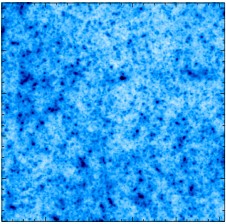This page introduce the MRLENS software (Version 1.0), contains links to our papers
and allow you to download a copy of the MRLENS software and its user manual.
INTRODUCTION :
This is the first version of the package MRLENS (Multi-Resolution methods for gravitational LENSing). We propose a method for Weak Lensing maps reconstruction.
Nowadays Weak Lensing provides a unique method to directly map the distribution of dark matter in the universe. It relies on the measurement of the distortions that lensing induces in the images of background galaxies. Unlike other methods that probe the distribution of light, Weak Gravitational Lensing measures the mass and can thus be directly compared to reliable theoretical models of structure formation.
Ongoing efforts are made to improve the detection of cosmic shear on existing telescopes and future instruments dedicated to survey are planned. Several methods are used to derive the lensing shear from the shapes of background galaxies. But the shear map obtained is always noisy, and when it is converted into a map of the projected mass map, the result is dominated by the noise. To succeed in probing the Universe with Weak Lensing a sophisticated algorithm is required to filter the mass map. Some basic algorithms are commonly used like Gaussian filter or Wiener filter but the result is not optimal.
The MRLENS package offers a new algorithm for the reconstruction of Weak Lensing mass maps. This new method uses the Multiscale Entropy concept (which is based on wavelets) and the False Discovery Rate (FDR) which allows us to derive robust detection levels in wavelet space. Many others tools useful to process lensing shears from real data or simulated one are available in the MRLENS software.
USER GUIDE :
The user manual introduces the Weak Lensing challenge and describes the MRLENS methods.
Some results are presented and an accurate description of IDL routines are available.
IDL MRLENS Software :
System Requirements : 1- Make sure you have approximately 400 MB of disk space available. After installation MRLENS package occupies approximately 56 MB or 205MB (version with data) of disk space.
2- The binaries C++ called by IDL routines are not available under all the systems therefore you cannot use the package on all platforms. The supported platforms are : SUN-Solaris, PC-Linux, Mac OS X. Next release will include PC Windows.
Software Requirements : The IDL MRLENS software requires that IDL (version 6.0 or later) to be installed on your computer. Starting IDL using the script program mrl.pro allows the user to add the MRLENS software to the IDL environment.
Thus, all routines described in the user manual can be called.
An online help is available by using the mrh.pro program.
DOWNLOAD :
Fast download : (Only binaries)
Standard Download : (binaries and data)
PUBLICATIONS :
This package is a compilation of some algorithms and methods which were developed and/or used successfully in the applications reported in the 2 following publications:
- Weak Lensing Mass Reconstruction using Wavelets
J.-L. Starck, S. Pires and A. Réfrégier, Astronomy and Astrophysics, March 2006
- Map of the universe's Dark Matter scaffolding
R. Massey, J. Rhodes, R. Ellis, N. Scoville, A. Leathaud, A. Finoguenov, P. Capak, D. Bacon, H. Aussel, J.-P. Kneib, A. Koekemoer, H. McCracken, B. Mobasher, S. Pires, A. Réfrégier, S. Sasaki, ,J.-L. Starck, Y. Taniguchi and J. Taylor, Nature, January 2007
- Sunyaev-Zeldovich cluster reconstruction in multiband bolometer camera surveys
S. Pires, J.-B. Juin, D. Yvon, Y. Moudden, S. Anthoine and E. Pierpaoli, Astronomy and Astrophysics, April 2006
More than a software dedicated to a new reconstruction method, this package includes many other tools useful to process, analyze and visualize lensing data. In this first version, we only focus in Weak Gravitational Lensing; Strong Gravitational Lensing will be added in a forthcoming version.
Last modified on 3rd March 2008 by Sandrine Pires
For questions and feedback or to be informed of the forthcoming versions, send an email to
• Modélisation, calcul, analyse des données › Méthodes de modélisation et de visualisation Structure et évolution de l'Univers › Evolution des grandes structures et des galaxies
• Department of Astrophysics (DAp) // UMR AIM • The Electronics, Detectors and Computing Division • Le Département d'Astrophysique (DAp) // UMR AIM • Le Département d'Électronique des Détecteurs et d'Informatique pour la Physique (DEDIP)
• pas de titre • Laboratoire d'ingénierie logicielle pour les applications scientifiques (LILAS)



